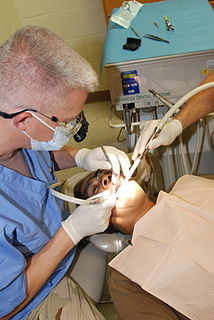
Dentistry, also known as dental medicine and oral medicine, is a branch of medicine that consists of the study, diagnosis, prevention, and treatment of diseases, disorders, and conditions of the oral cavity, commonly in the dentition but also the oral mucosa, and of adjacent and related structures and tissues, particularly in the maxillofacial area. Although primarily associated with teeth among the general public, the field of dentistry or dental medicine is not limited to teeth but includes other aspects of the craniofacial complex including the temporomandibular joint and other supporting, muscular, lymphatic, nervous, vascular, and anatomical structures.
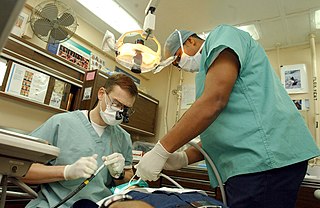
A dentist, also known as a dental surgeon, is a surgeon who specializes in dentistry, the diagnosis, prevention, and treatment of diseases and conditions of the oral cavity. The dentist's supporting team aids in providing oral health services. The dental team includes dental assistants, dental hygienists, dental technicians, and sometimes dental therapists.
Medical tourism refers to people traveling abroad to obtain medical treatment. In the past, this usually referred to those who traveled from less-developed countries to major medical centers in highly developed countries for treatment unavailable at home. However, in recent years it may equally refer to those from developed countries who travel to developing countries for lower-priced medical treatments. The motivation may be also for medical services unavailable or non-licensed in the home country: There are differences between the medical agencies world-wide, whether a drug is approved in their country or not. Even within Europe, although therapy protocols might be approved by the European Medical Agency (EMA), several countries have their own review organizations in order to evaluate whether the same therapy protocol would be "cost-effective", so that patients face differences in the therapy protocols, particularly in the access of these drugs, which might be partially explained by the financial strength of the particular Health System.
Cosmetic dentistry is generally used to refer to any dental work that improves the appearance of teeth, gums and/or bite. It primarily focuses on improvement in dental aesthetics in color, position, shape, size, alignment and overall smile appearance. Many dentists refer to themselves as "cosmetic dentists" regardless of their specific education, specialty, training, and experience in this field. This has been considered unethical with a predominant objective of marketing to patients. The American Dental Association does not recognize cosmetic dentistry as a formal specialty area of dentistry. However, there are still dentists that promote themselves as cosmetic dentists.
Prosthodontics, also known as dental prosthetics or prosthetic dentistry, is the area of dentistry that focuses on dental prostheses. It is one of 12 dental specialties recognized by the American Dental Association (ADA), Royal College of Surgeons of England, Royal College of Surgeons of Edinburgh, Royal College of Surgeons of Ireland, Royal College of Surgeons of Glasgow, Royal College of Dentists of Canada, and Royal Australasian College of Dental Surgeons. The ADA defines it as "the dental specialty pertaining to the diagnosis, treatment planning, rehabilitation and maintenance of the oral function, comfort, appearance and health of patients with clinical conditions associated with missing or deficient teeth or oral and maxillofacial tissues using biocompatible substitutes."
The UCLA School of Dentistry is the dental school of the University of California, Los Angeles (UCLA) located in the Center for Health Sciences building in the Westwood neighborhood of Los Angeles, California, United States. The school has several educational and training programs, conducts oral and dental health research, and offers affordable dental care at three locations: Westwood, Venice, and Inglewood. The school also participates in several outreach endeavors, including numerous health fairs during the year, STEM pipeline programs and provides dental care for underserved populations in the region. The School of Dentistry is considered among the nation's best research-intensive dental schools.
Dental insurance is a form of health insurance designed to pay a portion of the costs associated with dental care. There are several different types of individual, family, or group dental insurance plans grouped into three primary categories: Indemnity, Preferred Provider Network (PPO), and Dental Health Managed Organizations (DHMO).
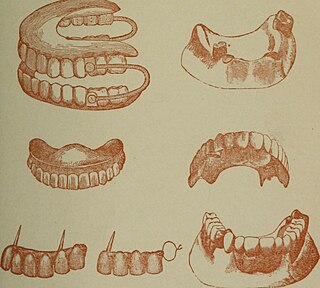
A denturist in the United States and Canada, clinical dental technologist in the United Kingdom or a dental prosthetist in Australia, is a member of the oral health care team and role as primary oral health care provider who provides an oral health examination, planning treatment, takes impressions of the surrounding oral tissues, constructs and delivers removable oral prosthesis treatment directly to the patient.

Dentistry throughout the world is practiced differently, and training in dentistry varies as well.
Due to the near-universal desire for safe and good quality healthcare, there is a growing interest in international healthcare accreditation. Providing healthcare, especially of an adequate standard, is a complex and challenging process. Healthcare is a vital and emotive issue—its importance pervades all aspects of societies, and it has medical, social, political, ethical, business, and financial ramifications. In any part of the world healthcare services can be provided either by the public sector or by the private sector, or by a combination of both, and the site of delivery of healthcare can be located in hospitals or be accessed through practitioners working in the community, such as general medical practitioners and dentists.
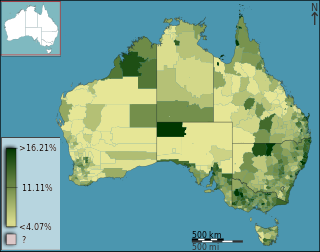
Australia has a highly developed health care structure, though because of its vast size, services are not evenly distributed. Health care is delivered in Australia by both government and private companies which are often covered by Medicare. Health care in Australia is largely funded by the government at national, state and local governmental levels, as well as by private health insurance; but the cost of health care is also borne by not-for-profit organisations, with a significant cost being borne by individual patients or by charity. Some services are provided by volunteers, especially remote and mental health services.
A medical tourism agent is an organisation or a company which seeks to bring together a prospective patient with a service provider, usually a hospital or a clinic. These organisations are generally facilitators and developers of medical tourism, which brings into play a number of issues that do not apply when a patient stays within their own country of origin.
Medical tourism in Israel is medical tourism in which people travel to Israel for medical treatment, which is emerging as an important destination for medical tourists. In 2006, 15,000 people came to Israel for medical treatment, bringing in $40 million in revenue. In 2010, Israel treated 30,000 medical tourists. The Health Ministry estimates that they inject about NIS 200 million a year into the health system, of which more than NIS 100 million goes to government hospitals. Outside experts put the total much higher, at almost NIS 500 million.
Special needs dentistry, also known as special care dentistry, is a speciality of dentistry concerned with the oral health of people who have intellectual disability, or who are affected by other medical, physical, or psychiatric issues.
Medical tourism is a growing sector in India. In October 2015, India's medical tourism sector was estimated to be worth US$3 billion. It is projected to grow at a CAGR of 200% by 2020, hitting $9 billion by 2020. In 2017, 495,056 patients visited India to seek medical care. The top 10 source countries for patients have been Bangladesh, Afghanistan, Iraq, Maldives, Oman, Yemen, Uzbekistan, Kenya, Nigeria and Tanzania, with significant number of patients also coming from Australia, Canada, Russia, the UK, and the United States. The city of Chennai has come to known as the healthcare capital of India.
Medical tourism in Pakistan is viewed as an untapped market that could be turned into a huge opportunity if the government "focuses on key issues". According to Pakistani medical experts, Pakistan has a "huge potential" in becoming a regional medical tourism hub, comparable to many other countries in its neighbourhood. Medical tourism in Pakistan has been arranging potential trips for many medical health and care procedures. A number of modern hospital facilities exist in major cities such as Islamabad, Karachi and Lahore that are fully equipped and facilitated with the latest medical technologies. Many doctors and surgeons in Pakistani hospitals tend to be foreign qualified. However, security issues and an overall below-par health infrastructure have challenged the growth of the industry.
A dental discount plan, also known as a referral plan, is a membership-based discount plan for dental health maintenance and intervention. In it, the patient pays the entire cost of a rate negotiated between the dentist and the referring company, usually between 10-60% of normal cost.
Medical tourism in the Republic of Moldova – is the branch of the tourism industry, providing the high-level treatment to the foreign patients. This industry gains more popularity each year and the number of medical tourists exceeds 30% of the total number of patients in Moldova’s clinics. Foreign citizens come to Moldova for qualitative treatment, which they cannot receive or allow in the country of origin.
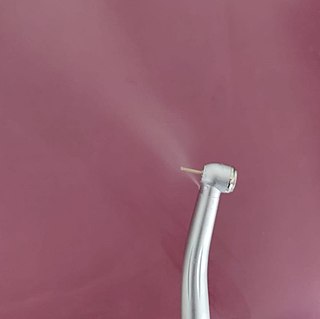
A dental aerosol is an aerosol that is produced from dental instrument, dental handpieces, three-way syringes and other high-speed instruments. These aerosols are air suspended in the clinical environment. These aerosols can pose risks to the clinician, staff and other patients as well. The heavier particles of the aerosols suspend in the air for relatively short period and settles down quickly, but the lighter particles tend to remain suspended for longer periods and are capable to enter and get deposited in the lungs when they are inhaled and possess the capacity of transmitting diseases.





